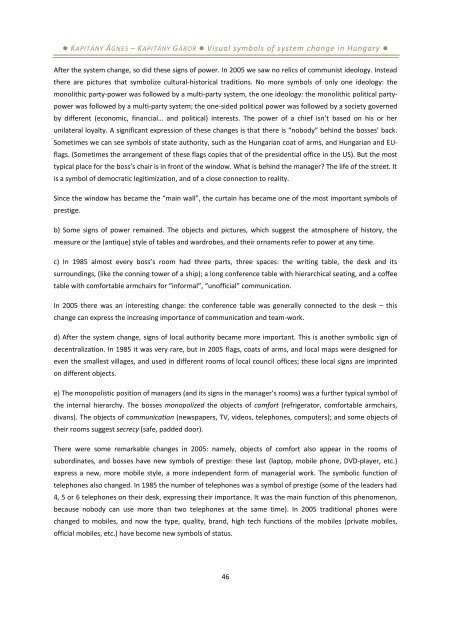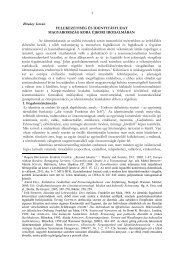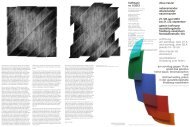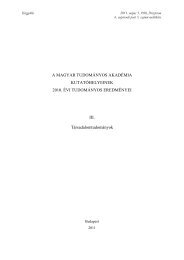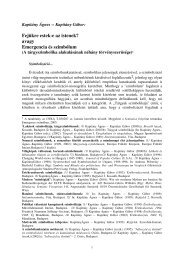symbolic elements of everyday culture - MTA Szociológiai ...
symbolic elements of everyday culture - MTA Szociológiai ...
symbolic elements of everyday culture - MTA Szociológiai ...
You also want an ePaper? Increase the reach of your titles
YUMPU automatically turns print PDFs into web optimized ePapers that Google loves.
● KAPITÁNY ÁGNES – KAPITÁNY GÁBOR ● Visual symbols <strong>of</strong> system change in Hungary ●<br />
After the system change, so did these signs <strong>of</strong> power. In 2005 we saw no relics <strong>of</strong> communist ideology. Instead<br />
there are pictures that symbolize cultural-historical traditions. No more symbols <strong>of</strong> only one ideology: the<br />
monolithic party-power was followed by a multi-party system, the one ideology: the monolithic political party-<br />
power was followed by a multi-party system; the one-sided political power was followed by a society governed<br />
by different (economic, financial… and political) interests. The power <strong>of</strong> a chief isn’t based on his or her<br />
unilateral loyalty. A significant expression <strong>of</strong> these changes is that there is “nobody” behind the bosses’ back.<br />
Sometimes we can see symbols <strong>of</strong> state authority, such as the Hungarian coat <strong>of</strong> arms, and Hungarian and EU-<br />
flags. (Sometimes the arrangement <strong>of</strong> these flags copies that <strong>of</strong> the presidential <strong>of</strong>fice in the US). But the most<br />
typical place for the boss’s chair is in front <strong>of</strong> the window. What is behind the manager? The life <strong>of</strong> the street. It<br />
is a symbol <strong>of</strong> democratic legitimization, and <strong>of</strong> a close connection to reality.<br />
Since the window has became the “main wall”, the curtain has became one <strong>of</strong> the most important symbols <strong>of</strong><br />
prestige.<br />
b) Some signs <strong>of</strong> power remained. The objects and pictures, which suggest the atmosphere <strong>of</strong> history, the<br />
measure or the (antique) style <strong>of</strong> tables and wardrobes, and their ornaments refer to power at any time.<br />
c) In 1985 almost every boss’s room had three parts, three spaces: the writing table, the desk and its<br />
surroundings, (like the conning tower <strong>of</strong> a ship); a long conference table with hierarchical seating, and a c<strong>of</strong>fee<br />
table with comfortable armchairs for “informal”, “un<strong>of</strong>ficial” communication.<br />
In 2005 there was an interesting change: the conference table was generally connected to the desk – this<br />
change can express the increasing importance <strong>of</strong> communication and team-work.<br />
d) After the system change, signs <strong>of</strong> local authority became more important. This is another <strong>symbolic</strong> sign <strong>of</strong><br />
decentralization. In 1985 it was very rare, but in 2005 flags, coats <strong>of</strong> arms, and local maps were designed for<br />
even the smallest villages, and used in different rooms <strong>of</strong> local council <strong>of</strong>fices; these local signs are imprinted<br />
on different objects.<br />
e) The monopolistic position <strong>of</strong> managers (and its signs in the manager’s rooms) was a further typical symbol <strong>of</strong><br />
the internal hierarchy. The bosses monopolized the objects <strong>of</strong> comfort (refrigerator, comfortable armchairs,<br />
divans). The objects <strong>of</strong> communication (newspapers, TV, videos, telephones, computers); and some objects <strong>of</strong><br />
their rooms suggest secrecy (safe, padded door).<br />
There were some remarkable changes in 2005: namely, objects <strong>of</strong> comfort also appear in the rooms <strong>of</strong><br />
subordinates, and bosses have new symbols <strong>of</strong> prestige: these last (laptop, mobile phone, DVD-player, etc.)<br />
express a new, more mobile style, a more independent form <strong>of</strong> managerial work. The <strong>symbolic</strong> function <strong>of</strong><br />
telephones also changed. In 1985 the number <strong>of</strong> telephones was a symbol <strong>of</strong> prestige (some <strong>of</strong> the leaders had<br />
4, 5 or 6 telephones on their desk, expressing their importance. It was the main function <strong>of</strong> this phenomenon,<br />
because nobody can use more than two telephones at the same time). In 2005 traditional phones were<br />
changed to mobiles, and now the type, quality, brand, high tech functions <strong>of</strong> the mobiles (private mobiles,<br />
<strong>of</strong>ficial mobiles, etc.) have become new symbols <strong>of</strong> status.<br />
46


